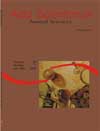<b>Additives vs concentrate levels in rations for buffaloes and cattle: dry matter <em>in vitro</em> digestibility</b> - DOI: 10.4025/actascianimsci.v29i4.1008
Abstract
This study evaluated the dry matter in vitro digestibility (DMIVD) of rations with 5 concentrate levels (0, 5, 10, 20 and 50%), and the absence or presence of additives (control, ionophore (Rumensin®) or probiotic (Beef-sacc)), consisting of a 5 x 3 factorial. It also evaluated the DMIVD of rations with 50:50% roughage:concentrate with or without addition of ionophore, probiotic, growth-promoting antibiotic (BMD®) and the combination of them, consisting of 8 treatments and 4 repetitions, using a randomized design. For all evaluated rations, ruminal liquid from a bovine and a buffalo was used. For both species, there was an interaction (p < 0.01) for increasing levels of concentrate and additives. For buffaloes, the ration with ionophore showed maximum DMIVD value (64.8%) for 41.9% of concentrate; control and probiotic rations presented similar values between them. For bovines, a superiority of probiotic over ionophore was observed in rations with up to 50% of concentrate. However, in isolated and combined effects among additives in rations with 50:50% roughage:concentrate on DMIVD, the results showed that the combinations are similar or inferior to the isolated effects of additives in both species.Downloads
Download data is not yet available.
Published
2008-03-06
How to Cite
Beleze, J. R. F., Zeoula, L. M., Jacobi, G., Candêo Filho, S. L., Kazama, R., & Paula, M. C. de. (2008). <b>Additives vs concentrate levels in rations for buffaloes and cattle: dry matter <em>in vitro</em> digestibility</b> - DOI: 10.4025/actascianimsci.v29i4.1008. Acta Scientiarum. Animal Sciences, 29(4), 417-424. https://doi.org/10.4025/actascianimsci.v29i4.1008
Issue
Section
Ruminant Nutrition
DECLARATION OF ORIGINALITY AND COPYRIGHTS
- I Declare that current article is original and has not been submitted for publication, in part or in whole, to any other national or international journal.
The copyrights belong exclusively to the authors. Published content is licensed under Creative Commons Attribution 4.0 (CC BY 4.0) guidelines, which allows sharing (copy and distribution of the material in any medium or format) and adaptation (remix, transform, and build upon the material) for any purpose, even commercially, under the terms of attribution.
Read this link for further information on how to use CC BY 4.0 properly.
0.9
2019CiteScore
29th percentile
Powered by 








































